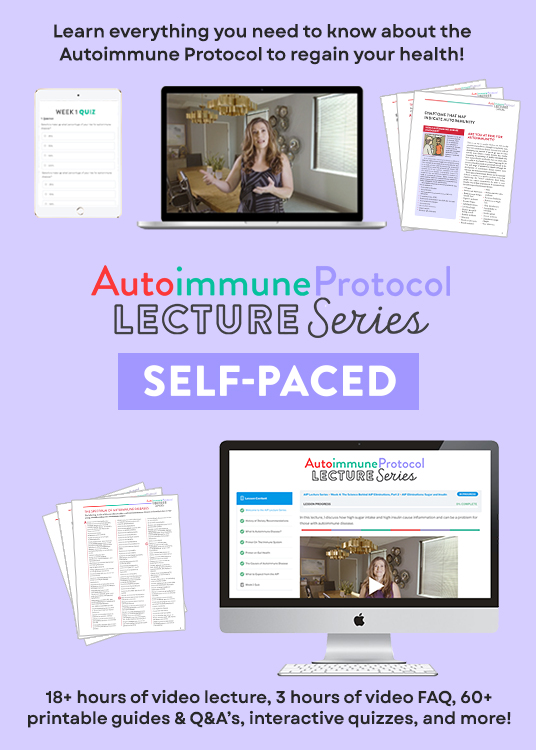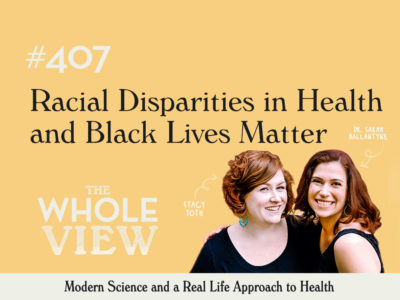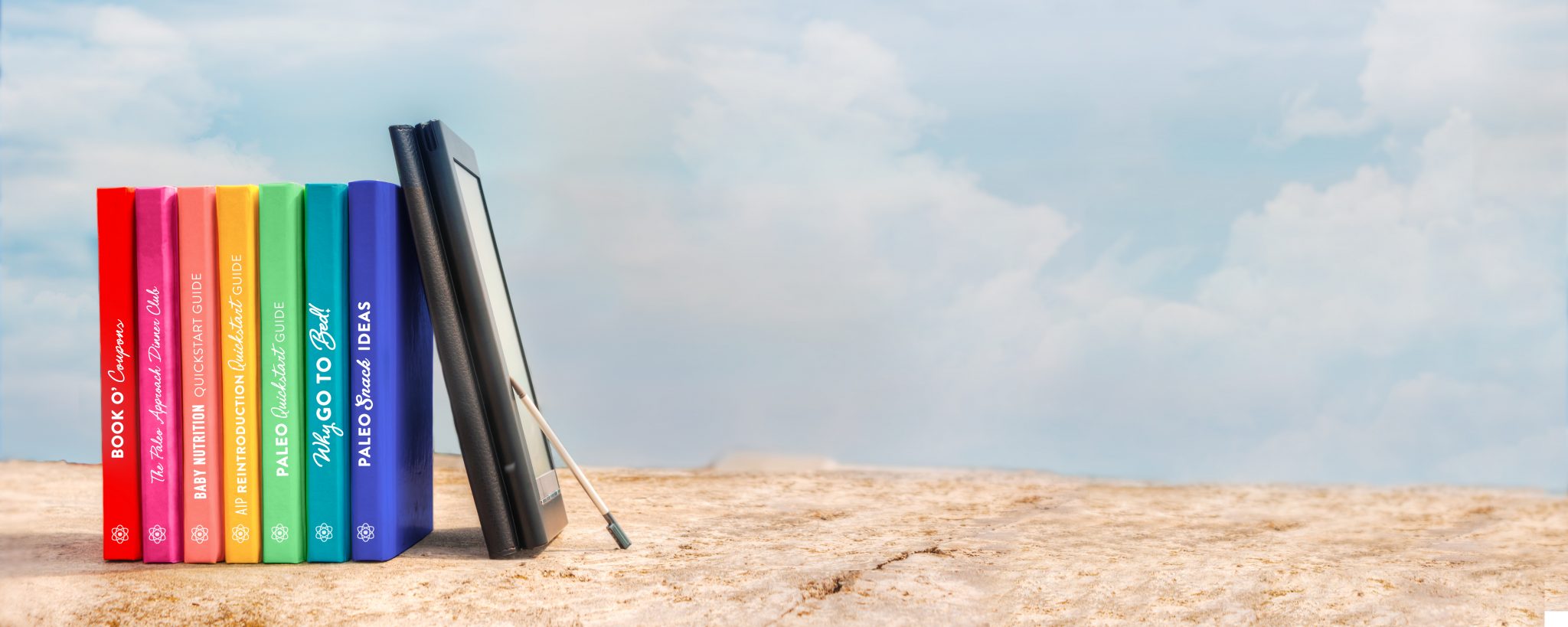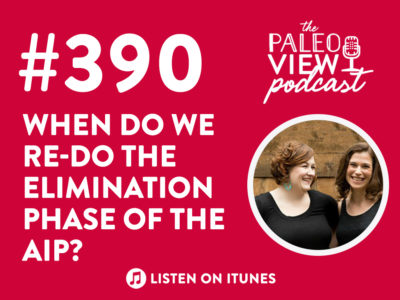Welcome to episode 407 of The Whole View. This week Stacy and Sarah take a look at how covid-19 has disproportionally affected the Black community, and with data-driven information, connect a dot to how this has stemmed from racial disparities within the health system as a whole. Learn more about the recent events that have led to this historical moment in time, and what each and every one of us can do to support the Black Lives Matter movement.
Table of Contents[Hide][Show]
- The Whole View, Episode 407: Racial Disparities in Health and Black Lives Matter
- Stacy’s Reflection
- Sarah’s Reflection
- The Start of a Political Uprising
- Racial Disparities in Covid-19
- Racial Disparities in Chronic Disease
- Digging Deeper into the Statistics
- Economic Disparities
- We Can Do Better
- Where to Start
- Statistics on Police Brutality
- Ways to Support the Black Lives Matter Movement
- Additional Ideas
- Closing Thoughts
If you enjoy the show, please review it on iTunes!
The Whole View, Episode 407: Racial Disparities in Health and Black Lives Matter
Hey listeners, welcome back to the Whole View, episode 407. (0:27)
Stacy knows that this might sound a little unusual, but this is one of the reasons that we do weekly recordings so that we can address things that are happening in the real world.
With everything that is going on right now, it didn’t seem right to record the podcast as planned.
However, Stacy and Sarah wanted to instead open up a conversation with listeners.
We have been having conversations amongst ourselves, and feel passionate that it is important to talk about the racial disparities that cause things we talk about on this podcast all the time.
To dive into that a little bit deeper is important, and we want to discuss what all of us can do to support the Black Lives Matter movement.
If you are listening to this podcast at a later time, this is being recorded during the first week of June.
This is a week where we as a nation are examining how we treat the Black community.
Stacy noted that we will not be perfect in this show, but both she and Sarah are going to give it their best effort to bring these topics to the table.
Save 70% Off the AIP Lecture Series!
Learn everything you need to know about the Autoimmune Protocol to regain your health!
I am loving this AIP course and all the information I am receiving. The amount of work you have put into this is amazing and greatly, GREATLY, appreciated. Thank you so much. Taking this course gives me the knowledge I need to understand why my body is doing what it is doing and reinforces my determination to continue along this dietary path to heal it. Invaluable!
Carmen Maier

Sarah feels it is important to preface this show that they are going to do what they always do and discuss health, wellness, and safety, driven by science, and intersect that with the real-life emotional and physical experience.
And that is what we are going to do in this week’s episode, and dive into how all of these things are disproportionally affecting the Black community.
We are going to discuss how this has been a major contributor to this moment in history.
It is also really important to preface this entire conversation by expressing our solidarity with the Black community against racism, against injustice, and against senseless violence.
Stacy’s Reflection
Stacy wants to also note that both Sarah and Stacy are college-educated, white women who live in the suburbs. (2:36)
They cannot possibly understand the Black experience.
However, we stand with the ideals of quality, safety, and wellness for all, as we talk about on this show all the time.
Stacy personally felt like her beliefs aligned with that, but she had this moment of realization when a reader called Stacy out and held her accountable.
She is so grateful for this.
At first, she felt defensive of this, but the more that she thought about it the more she realized how it was important to not just personally not be a racist but to instead be anti-racist.
The thing that really clicked for Stacy was when this reader said, “but being gluten-free and using non-toxic skincare won’t matter if I am dead in the street.”
Stacy was also reading another resource on the principles of the hierarchy of your psychological state of well-being.
At the very core, at the lowest rung, is safety.
If you don’t feel safe, you can’t get to anything else.
There is no ability in your cognitive thought process to handle more complicated mattes.
Putting those things together and realizing that gluten doesn’t matter if you are worried about your safety when you go out having done nothing wrong.
Stacy didn’t at first talk about this because she didn’t feel like she had the right words or she didn’t know where to start.
However, she wants to put it out there that as all of us start to have these conversations it is going to be hard.
And it will be uncomfortable, but doing that hard work (including putting ourselves out there right now) creates a sense of fear from backlash.
But Stacy wants to say that choosing not to speak is part of that privilege that most of us are born into.
When Stacy imagines that fear of discomfort as being something you have your whole life because of the color of your skin, that is the Black experience all the time.
Stacy just can’t sit by and say that is ok.
We can do something.
We can help people try to understand, and that is our goal today.
Stacy appreciates your patience with us as we tackle something new but very important.
Sarah’s Reflection
For Sarah, her experience has been similar in the sense of starting with a sense of discomfort around finding the right words to express herself. (6:44)
Trying to find the right way to express solidarity with the Black community.
The feelings of nervousness and awkwardness have been compounded with being an immigrant.
This part of the immigration experience where Sarah feels she is not supposed to criticize her adopted home.
However, she has come around to really viewing the data that we will share in this episode, as something more important.
It is about building awareness of a systemic problem that needs to be fixed so that our country can be better for everyone in it.
The Start of a Political Uprising
We are talking about centuries of systemic racism. (8:19)
And now, we are talking about a situation where the global pandemic has really drawn the curtain back and revealed the extent of how systemic racism is impacting people of color.
How covid has so disproportionally affected those communities and how the economic depression that has been caused by covid has centralized within those communities.
It has created distinct energy within this climate.
In fairly rapid succession, we had Amy Cooper in Central Park who called the police on Christian Cooper.
We had the murder of Ahmaud Arbery.
Then we had the Breonna Taylor shooting, where she was killed by police in her home.
And then most recently we had the homicide of George Floyd by a police officer while three other officers watched.
This is not the first tragic example of police violence against a person of color.
However, it is the spark on this that has lit this powder keg that is the frustration of all of these events coming together.
It is this unique period of time where the depth of systemic racism is so visible in the covid-19 data and then ignited by these recent examples of racism.
For a deeper look at this, please refer to this link.
What we are going to do is get into the actual science and the data behind these events that have led to the current events.
There are 140 different cities and towns, at least, in the country where there are protests supporting the Black Lives Matter movement.
All of those of us who are in the periphery need to be able to support this community.
Stacy reflected a bit more on Sarah’s perspective as an American immigrant.
She feels passionate that immigrants and people of color make America what it is today.
Stacy hopes that this information they are going to share can help highlight how things are pulling us apart instead of pulling us together.
Here is an opportunity to change.
There is nothing we can do about the past.
This is an opportunity to take in the information and ask, now that I know better, how can I do better.
Racial Disparities in Covid-19
What has really been problematic is that there isn’t comprehensive data on race and ethnicity in the covid-19 data. (15:18)
There are isolated places that are keeping data and there are a variety of organizations that are trying to gather and analyze that data.
The CDC does have an entire page dedicated to the racial disparities in covid-19.
There are only looking at data from about 580 patients.
The APM Research Lab has found that Black Americans have mortality rates that are more than twice as high as other races.
There are more covid cases amongst the African American community because they are much more likely to work in the service industry and much more likely to not have paid sick leave.
And there is a higher mortality rate because of pre-existing racial disparities in both chronic illness and access to health care.
So what is happening right now, looking at the data, is that the disparities are different in different regions.
On average, the disparity is that African Americans are dying at a little over twice the rate as white Americans.
However, there are places where the disparity is closer to five times higher (ex, Louisiana).
In Michigan, it is 10 times higher.
We can see a greater disparity in different regions of the country where this data is being collected, we can see a greater disparity.
And In North Carolina, the difference is 50%, which is still not ok.
What this is showing us is this collection of different factors that are contributing to this.
For example, nearly a quarter of employed African American workers work in the service industry, compared to only 16% of non-Hispanic whites.
They are far more likely to be considered an essential employee.
For example, even though Black Americans only make up 12% of all employed workers, they make up 30% of practical and licensed vocational nurses.
They are caring for people with covid-19, so they are high-risk by the sheer nature of the work they are doing.
Here are three articles to refer to for more information: one, two, and three.
Racial Disparities in Chronic Disease
We are compounding that onto a pre-existing problem where there are huge racial disparities in chronic disease. (19:19)
There are a variety of reasons for this.
Sarah has seen this referred to as being a “complex disparity ecosystem”.
This basically means that there are a lot of factors that are all contributors to this disparity.
It includes things like lower levels of economic resources, lower levels of access to health care, delays in treatment, lower health literacy rates.
This also includes environmental factors.
Black Americans are more likely to have contaminated water or being exposed to environmental pollutants, and less likely to have access to a grocery store that has fresh produce.
All of these are contributing to a much higher prevalence of all of the risk factors for a severe case of covid-19.
African Americans have a 70% higher rate of diabetes than white Americans.
There are higher rates of cardiovascular disease, especially stroke.
And there is nearly double the rate of hypertension, high blood pressure, which is one of the strongest risk factors for a severe course of covid-19.
There are also higher rates of cancer.
For example, the cancer rate in African Americans is 35% higher than for whites.
Digging Deeper into the Statistics
This is one of the big challenges for the Black community.
It is not just the increased exposure to covid, it is not just that they make up a larger proportion of the people who are getting it.
However, it is that they are far more likely to have these pre-existing conditions that make them more likely to have a severe course of the disease.
And on top of all that, compared to white Americans, African Americans are about twice as likely to uninsured.
If you look at various surveys, Black Americans are much more likely to report not being able to see a doctor because of the cost.
They are far less likely to have employer-based health insurance.
So there is increased exposure because of economics.
Then there is the more likely to have a pre-existing condition that increases the likelihood of a severe course of the disease.
And then there is the less likely to see a doctor get the appropriate levels of healthcare.
All of that together has led to these disparities as to how covid-19 is impacting the Black community.
Economic Disparities
The other thing that we have seen is an economic depression. (22:47)
We haven’t seen rates of unemployment like this ever, and this has disproportionally impacted people of color.
A Pew Research Center survey shows that Latinx and Black households are being hit with more job losses than White ones.
Sixty-six percent of Latinx households and 44 percent of Black households have had a job or wage loss due to the pandemic, compared to 38 percent of White households.
There’s also a wealth gap, so these are people who are much less likely to have savings, own a home, etc.
According to our Racial Wealth Divide report, the median Black family, with just over $3,500, owns just 2 percent of the wealth of the nearly $147,000 the median White family owns.
One of the things that Stacy has come around to understand more is the different ways to represent economic disparities.
When we say something like a Black family has less wealth than a white family, let Stacy give some tangible numbers in an article she read based on where she lives.
The average median household income for a Black family is $84,000.
Matt and Stacy live in one of the most expensive costs of living areas in the country.
However, if you look at the white median income, it is $118,000.
So it is not just the difference between whether someone is college-educated or not, this goes back so long into things that have built systemic racism into our country.
Oftentimes we don’t even realize our culture is making racial assumptions for.
Stacy feels that this goes into a lot of bias in the healthcare world as well.
Because it is more likely that these conditions exist in Black Americans, it is also assumed, or bias is given, and lack of care.
You are seeing not just an impact from the fact that they have an increased risk of health conditions.
But you are also seeing they are not getting proper medical care because of bias and assumptions that are being made by healthcare professionals.
We Can Do Better
We, as white people, are never going to understand the Black experience. (27:30)
But we can try to put ourselves in a situation where we can know that things are happening are not ok.
We can use our voice to speak on behalf of those that are being marginalized or being oppressed.
Stacy tries to do this for all communities who affect health, and realizing now is not something she has been doing for people of color who find themselves in these situations regularly.
We as a country can do better, and there is so much that we need to learn to do that.
Where to Start
One resource, a podcast episode that Sarah listened to a few days ago, that she would like to point listeners to is Hidden Brain, The People Like Us. (28:21)
This podcast episode broke down how covid-19 disproportionally impacts people of color and then looked at ways healthcare could be improved to address these inequalities.
One of the things we want to do in this episode beyond bringing the data into this conversation is to help our listeners with at least some starting places of resources that both Stacy and Sarah have found helpful.
Stacy and Sarah are being very intentional in trying to reflect and learn and educate themselves in this time.
The more that we listen, the more that we learn, the more that we read, the more we support the communities that need us to understand and speak on behalf of.
One of the things that Stacy is doing is having an activity to teach her children about racism, privilege, and how we as privileged white people can use our voice on behalf of those who are not as unfortunate.
There are videos she has been showing them, and then asking questions afterward.
They have also been watching a movie at night to learn about Black culture, racism, or civil rights every single night as well.
Stacy feels that her kids do not need to consume the negativity of the news, but they do need to be aware of what is happening in the world.
These children will inherit this earth and can continue to make changes.
Learning not just why it is important to vote, but how to also participate in local elections and that it is our responsibility to do so.
Stacy is realizing how grateful she is for quarantine because of the opportunity we have to control the narrative on what our kids are seeing and hearing.
We can shape how kids reflect and learn about this.
Statistics on Police Brutality
This is one of the problems is that there is no comprehensive federal database on violent incidents with police. (34:44)
After Michael Brown’s death in Ferguson, Missouri in 2014, there were a variety of independent third parties that took up the mantle of tracking this data.
There are now a few that do this called Fatal Encounters, Mapping Police Violence, and the Washington Post’s Fatal Force Project.
They collect data in different ways, tracking slightly different, and also counting different things.
Over the last six years, they have revealed some statistical trends.
On average there has not been much change in the past six years in terms of police violence and lethal force being used.
There is some shift where it is decreasing in some of the big cities that have had initiatives to not use lethal force and have really worked on really changing the police culture.
In big cities, the rate of people being killed by police has gone down, but it has gone up in suburban and rural communities.
On average, it is about the same.
Last year, there were a little over 1,000 people killed by police as found by Mapping Police Violence.
Black people are about 2.5x more likely to be killed.
They are disproportionally represented in that group.
In addition, they are more likely to be unarmed than a white person when they are killed.
There are people who are looking at this data trying to tease out and understand ways to address it.
Some ways have been shown to be completely ineffective.
For instance, body cams have been shown to not impact the police brutality rates at all.
Bias training, on the whole, has been shown to be relatively inaffective as well, which may have to do with the variety in which bias training is conducted.
There was a study published last fall in the Proceedings of the National Academy of Sciences that estimated that a Black man in America had approximately one in one-thousand chance in being killed by police in his lifetime.
The chance is of course much higher in that twenty-five to thirty-five age range.
That statistic is really eye-opening.
Sarah pointed out that the mortality rate is not much different from covid-19.
For more information on this topic, see here, here and here.
Stacy noted that whatever bias or assumption you have on these statistics, those have already been corrected for.
Ways to Support the Black Lives Matter Movement
This is what we mean by learn and seek out this information for yourself. (39:44)
Knowledge is power.
The more knowledgeable we become on this, the more we can have those conversations that say something contrary to support Black Lives Matter.
If you have the education and information you can help do the hard work.
Black lives matter, and these conversations need in order to protect those lives that we have talked about.
We can stand up, and get comfortable being uncomfortable speaking up for the marginalized group and people of color, and Black Americans specifically.
One of the things that Sarah has been learning about in particular is learning about the language used to describe the Black Lives Matter protests right now.
This has also led Sarah to examine her own language and unconscious bias.
A Black Lives Matter protest is much more likely to have the words violent used to describe it, or to be called a riot.
Examine the language being used.
The current protests are standing up to injustice, and they are very important.
They are demanding change that should have already happened.
The other thing that Stacy wants to say is that this is not to say that there are not numerous people across all walks of life who are not wonderful allies.
One of the things that we can do is be an ally in the future.
The more we acknowledge and apologize for what is happening and openly come out and be an ally going forward, the more we lend to that positive protest.
This is our way of being able to support change.
Another thing that Stacy has been trying to do is share content from Black voices to help amplify them.
The example she brought up was following Charlotte on Instagram.
Add people to your network and community – seek them out and engage.
When we only see our own type of people (whether it is gender, age, the color of skin, etc.) we are all better served when we have diversity in our life.
Being able to find Black voices who are talking about this, or going forward you want to make sure you are supporting the work and shops of Black people, this will help their ability to get past those economic disparities.
There are a lot of people outside of our communities who will bring joy and depth and knowledge and interest and comedy to our lives.
Stacy knows she is better when she is bringing diversity into her life.
Additional Ideas
Sarah read an article in the Independent that really spoke to her in terms of giving her an action list for ways that she can support the Black community at this time.
Here was an expert Sarah wanted to share from “Not Racist” to Antiracist, article by Michael Crawford:
“Make a commitment to fighting for racial equity and move to action by challenging racist words and actions from people you know, donating money to civil rights organizations like Color of Change, Minnesota Freedom Fund Inc. and Fair Fight; signing petitions by groups like MoveOn; giving your children books featuring diverse characters; posting antiracist articles on Facebook; writing letters to the editor of your local newspaper urging justice; calling your city council members and demanding better oversight of the police department; calling the offices of progressive candidates to volunteer; and making sure you’re registered to vote.”
Danielle Coke is another Instagram account Stacy noted.
This YouTube video is another great resource to reference.
And here is a list of books to reference for additional education surrounding this discussion.
Laslty, here is a list of organizations you can volunteer for or donate to.
Closing Thoughts
If you are feeling some kind of way right now, like Stacy, and are realizing that you want to do more and that you are struggling with having not done those things previously, remember what we always say. (49:33)
Looking behind with shame and guilt does not help you move forward.
However, being of service, making a difference, and focusing on what you can do going forward is going to help effect change for this community.
Wallowing in guilt or shame or feeling confused and not doing anything will not help to bring change.
We are putting all these references in the show notes for you and we hope that it serves as an opportunity for you to continue the discussion.
Stacy has heard and read from Black voices over and over again that the best we can do is apologize for what has happened in the past.
It is not ok.
We can acknowledge that we are an ally and want to affect change going forward.
Then we can listen and learn so we can do just that.
These are Stacy’s principles going forward.
Listeners, Stacy hopes that this is helpful for you to go forward.
Take a deep breath and think about what can you do.
There are little things that we can all do, that will lead to big change.
Sarah wants to again acknowledge that both Stacy and Sarah are trying to use their platform to acknowledge where they know they can do better.
They are not trying to just express their solidarity with the Black community, but also bring awareness to the social injustices and racial disparities that have built this moment.
We encourage our listeners, please remember that this isn’t about being perfect, it is about taking those first steps down the road.
Stacy and Sarah are hoping to use their platforms to build awareness so that they can encourage all of our listeners and the people in your lives to advocate for equality.
That is what this is about.
Know better, do better.
We can apply that to every facet of our life.
We hope that this can help you find a way to do that in your own life.
Thank you for your patience as we worked through this, we hope that this inspires you to do your best.
Huge thank you for listening and we will be back again next week! (54:05)










